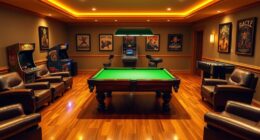Control panels with joysticks, buttons, and trackballs serve as essential interfaces for controlling complex machinery and systems. You can experience precise, tactile input with these controls, helping you operate equipment smoothly and efficiently. Joysticks allow directional movement, buttons provide quick-access functions, and trackballs facilitate detailed adjustments. Combining these features, control panels support comfortable, intuitive operation. To learn more about how these components optimize control panel performance, continue exploring their applications and benefits.
Key Takeaways
- Control panels combine physical controls like joysticks, buttons, and trackballs for precise and tactile system operation.
- Joysticks provide directional input for machinery movement and navigation.
- Buttons enable quick access to functions, often grouped for efficiency.
- Trackballs allow smooth cursor movements for detailed adjustments.
- Integration with touchscreens enhances usability and ergonomic comfort in complex environments.

A control panel serves as the central hub for managing and monitoring various electronic and mechanical systems. When you step into a control room or work station, you rely on its layout and features to keep everything running smoothly. Modern control panels often incorporate touchscreen integration, which allows you to interact directly with digital interfaces, making system adjustments quick and intuitive. With a well-designed touchscreen, you can access complex settings and data at a glance, reducing the need for multiple physical controls and streamlining your workflow. This technology enhances your ability to monitor real-time information, change parameters, and troubleshoot problems efficiently. The seamless integration of touchscreens into control panels also means you spend less time searching for the right button or switch, which boosts safety and productivity. Additionally, conflict resolution techniques can be employed when issues arise, ensuring smooth operation even under pressure.
Equally important is ergonomic design, which is essential for maintaining comfort and reducing fatigue during long shifts or intensive operations. When you use a control panel built with ergonomic principles, the placement of joysticks, buttons, and trackballs is optimized for your natural movements. This thoughtful arrangement minimizes strain on your hands and wrists, enabling you to work more precisely and comfortably. Ergonomic design considers factors like button size, tactile feedback, and the positioning of controls relative to your line of sight and reach. For example, control panels with adjustable angles or customizable interfaces allow you to tailor the setup to your specific needs, guaranteeing maximum efficiency and comfort. When controls are easy to access and operate, you can react faster to changing conditions, which is vital in high-stakes environments such as manufacturing, transportation, or defense.
Joysticks, buttons, and trackballs are fundamental components that complement touchscreen features, offering tactile feedback and precise control for different applications. Joysticks give you directional input, perfect for maneuvering machinery or navigating complex systems. Buttons provide quick access to essential functions, often grouped logically for ease of use, while trackballs enable smooth, cursor-like movements for detailed adjustments. These physical controls are especially valuable when touchscreen use isn’t practical, such as in environments with gloves or high levels of vibration. When integrated thoughtfully into a control panel with ergonomic design in mind, these devices enhance your ability to operate equipment accurately and efficiently. Together, touchscreen integration and ergonomic principles create a user-friendly interface that adapts to your needs, whether you’re managing industrial processes, operating machinery, or controlling sophisticated systems. This combination guarantees you maintain control with comfort, speed, and confidence, no matter how complex the task.
Frequently Asked Questions
How Do I Troubleshoot Unresponsive Control Panel Components?
To troubleshoot unresponsive control panel components, start by checking the component wiring for loose or damaged connections. Make certain all cables are securely connected and free of corrosion. Next, look for signal interference from nearby electronics that might disrupt operation. If issues persist, test the components individually or swap in known working parts to identify faulty hardware. Regular maintenance and clean connections help prevent future problems.
What Are the Best Practices for Installing Control Panels?
When installing control panels, you should prioritize a well-thought-out panel layout that minimizes clutter and maximizes accessibility. Focus on ergonomic design to guarantee comfortable use during extended periods. Secure all components firmly to prevent movement, and double-check wiring connections for safety. Test the panel thoroughly before final installation, making adjustments as needed. Proper planning and attention to ergonomic details help ensure reliable operation and user comfort.
Can Control Panels Be Customized for Specific Applications?
Think of control panels as a blank canvas ready for your masterpiece. Yes, you can customize them to fit your needs, selecting from a variety of customization options. With application-specific controls, you tailor each button, joystick, or trackball to perform precisely what you require. This personalization guarantees seamless operation, enhances efficiency, and transforms your control panel into a perfect extension of your workflow.
What Maintenance Is Required for Long-Term Durability?
To guarantee your control panel lasts, regularly check sensor calibration and clean components to prevent dust buildup. Protect the panel from environmental elements like moisture and extreme temperatures by using suitable enclosures. Inspect buttons, joysticks, and trackballs for wear and tear, replacing parts as needed. Keep connections tight and free of corrosion. Proper maintenance extends durability and keeps your control panel functioning smoothly over time.
Are There Wireless Control Panel Options Available?
Think of it like a modern magic wand — yes, wireless control panels are available now. You can enjoy wireless connectivity, which simplifies setup and reduces clutter. Just remember, you’ll need to manage the batteries wisely to keep your control panel powered. Regular charging or replacing batteries guarantees uninterrupted operation. With these options, you gain flexibility and convenience, making your control experience smoother and more efficient.
Conclusion
When you choose the right control panel, you’re holding the heartbeat of your entire system in your hands. Whether it’s a joystick, buttons, or a trackball, these tools transform your commands into seamless action. Think of them as the conductor’s baton, guiding your machine with precision and confidence. With the right control panel, you’ll navigate your tasks like a skilled captain steering through calm and storm alike—empowered and in control every step of the way.









